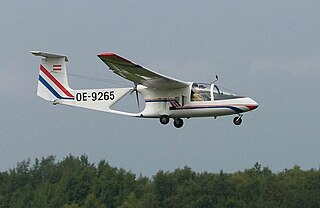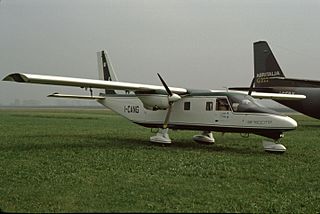
The Cessna 421 Golden Eagle is an American six or seven seat twin-engined light transport aircraft, developed in the 1960s by Cessna as a pressurized version of the earlier Cessna 411.

The PZL-Mielec M-20 Mewa is a licence-built version of the Piper PA-34 Seneca II manufactured in Poland by WSK PZL Mielec in a limited series from the 1980s.

The Socata TB 30 Epsilon is a light military trainer aircraft produced by SOCATA. It is a tandem two-seater with a metal airframe. The first prototype flew on 22 December 1979.

The Air Tractor AT-400 is a family of agricultural aircraft that first flew in the United States on September 1979. Type certification was awarded to Air Tractor in April 1980. Of low-wing monoplane taildragger configuration, they carry a chemical hopper between the engine firewall and the cockpit.

The Air Tractor AT-500 is a family of agricultural aircraft that first flew in the United States on 25 April 1986, manufactured by Air Tractor Inc. Of monoplane low-wing, taildragger configuration, they carry a chemical hopper between the engine firewall and the cockpit. Compared with their predecessor, the AT-500 family mostly feature a wingspan increased to 50 ft, and an additional fuselage stretch of 22 in (56 cm), allowing for a larger chemical hopper. Almost all variants offer a widened "buddy" seat or a tandem seat for a passenger, observer, or loader; trainer aircraft with full dual controls have also been offered.
The Anahuac Tauro is a Mexican agricultural aircraft built in small numbers in the late 1960s and 1970s. The first prototype flew on 3 December 1968, with Mexican Type certification following on 8 August 1969. It was a low-wing braced monoplane of conventional configuration with fixed tailwheel undercarriage. The wing was of constant chord and had spray bars installed along its trailing edge.

The Brditschka HB-3, HB-21 and HB-23 are a family of motor gliders of unorthodox configuration developed in Austria in the early 1970s.

The Aviasud Mistral is a French two-seat ultralight biplane built by Aviasud Engineering. This plane is notable as it has forward swept wings and side-by-side seating. The lower wings are movable and are used as the roll control.

The Vulcanair SF.600 Canguro was a feederliner developed in Italy in the late 1970s. Despite a number of attempts to put the aircraft into series production, only a small number were ever built. The Canguro was a high-wing cantilever monoplane of conventional configuration with a fuselage of rectangular cross-section and a high-set tail. The tricycle undercarriage was not retractable, and its main units were carried on sponsons on the fuselage sides. SIAI Marchetti provided funding towards the construction of the prototype, and constructed this aircraft at the former Aviamilano plant. After flight testing proved positive, the type was put on sale, but failed to attract buyers in any number, even when the original piston engines were exchanged for turboprops and retractable undercarriage was offered as an option.

The Gyroflug SC 01 Speed Canard is an unconventional sports plane produced in Germany in the 1980s and 1990s. Inspired by the Rutan VariEze, the Speed Canard was an all-new design created without input from Rutan. Like the VariEze, the Speed Canard is a canard-configured mid-wing monoplane with wingtip fins that incorporate rudders. The two-seat tandem cockpit and canopy design were derived from Grob Twin Astir sailplane, and the nosewheel of the tricycle undercarriage is retractable. Construction throughout is of composite materials, and when the design attained German certification in 1983, it became the first composite canard design to achieve certification anywhere in the world. An interesting feature of the control system is that the twin rudders operate independently, allowing both rudders to be deflected outwards simultaneously, cancelling each other's yaw, but acting as airbrakes.
The Hawk GafHawk was a small, turboprop-powered freighter aircraft developed in the United States in the 1980s but which only flew in prototype form. It was designed by Hawk International as a means of transporting drilling equipment in and out of remote locations, and was designed to be simple, rugged, and have good STOL and rough-field performance. The resulting design was a boxy aircraft with a rectangular-section fuselage with a high-set tail and rear loading ramp. The high aspect-ratio wings were high-set and braced with stuts. The landing gear was fixed and of tricycle configuration, with the main units having dual wheels.

The IAR-46 is a very light two-seater airplane for flight schools, training and tourism. Construction uses conventional riveted joints. The seats are arranged side by side, the conventional left seat being the pilot or student pilot seat. The aircraft has a low trapezoidal wing, empennage in "T" configuration, semi-retractable landing gear (mechanical), with the tailwheel connected to the rudder.
The Thurston TA16 Trojan was a light amphibious aircraft developed in the United States during the 1970s for homebuilding. During the 1980s and again in the early 2000s, efforts were made to certificate the design for series production under the name Seafire. It was a four-seat all-metal flying boat with a shoulder-mounted cantilever wing and a T-tail. The engine was mounted tractor-fashion on a tall pylon above the wings, and the aircraft was equipped with retractable tricycle undercarriage for alighting on land.

The Angel Aircraft Corporation Model 44 Angel is a twin-engine STOL utility aircraft produced in the United States since the mid-1990s. Designed by Carl Mortenson and The King's Engineering Fellowship to be well-suited for missionary work from remote locations around the world, it is a low-wing cantilever monoplane with a retractable tricycle undercarriage and eight seats. The design is largely conventional, with the exception that the engine nacelles are mounted on top of the wings in a pusher configuration. Construction is aluminum throughout the airframe.

The Promavia F.1300 Jet Squalus, also known as Promavia Jet Squalus F1300, was a two-seat light jet trainer designed by Italian Stelio Frati and built by Promavia in Belgium with support from the Belgian government.

The Valentin Taifun is a two-seat self-launching sailplane designed and built by Valentin Flugzeugbau GmbH of Hasfurt, Germany.

The PZL-126 Mrówka (ant) is a Polish agricultural aircraft first flown in 1990. It is a diminutive low-wing monoplane of conventional if stubby appearance with a cruciform tail, an enclosed cabin and fixed, tricycle undercarriage. Significant parts of the design were undertaken by students at the training college attached to the PZL plant at Okęcie under the direction of Andrzej Słocinski, with the whole project treated initially as a platform for design innovation. Initial design work was completed in 1982 and detail work the following year. Plans to fly a prototype by 1985 were delayed by revisions to the aircraft's equipment, although a mockup was displayed at an agricultural aviation exhibition at Olsztyn that August. Legislation to outlaw certain agricultural chemicals was under consideration in Poland in the late 1980s, spurring interest in biological agents as an alternative and making a tiny aircraft like the Mrówka feasible as a useful piece of agricultural equipment.

The Robin R 3000 is a French single-engined light aircraft designed and built by Avions Robin, which entered production in the 1980s.

The Scheibe SF 34 Delphin is a two-seat sailplane that was produced by Scheibe in Germany in the late 1970s and 1980s. Designed by Wolf Hoffmann and originally designated the SF H34, it was Scheibe's first unpowered aircraft of composite construction.
The Civil Aviation Department MG-1 was a one-off Indian motor glider, seating two side by side and first flown in 1983.
















